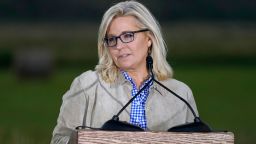Wyoming Rep. Liz Cheney, who since the January 6, 2021, insurrection at the US Capitol has become the Republican Party’s most forceful critic of former President Donald Trump, was ousted from her House seat by Trump-backed Harriet Hageman, CNN projected Tuesday.
In Alaska, voters cast ballots in another race the former President is focused on, with Republican Sen. Lisa Murkowski squaring off in the first of two rounds against the Trump-endorsed Kelly Tshibaka.
Former Gov. Sarah Palin, meanwhile, is attempting a political comeback in a special election for the state’s lone House seat.
Here are six takeaways from Tuesday’s contests in Wyoming and Alaska:
Trump caps his purge of intraparty rivals
Trump and his allies have spent the spring and summer turning Republican primaries across the political map into bitter fights in which loyalty to the former President was the central factor.
He lost some high-profile battles, including in Georgia, where Gov. Brian Kemp and Secretary of State Brad Raffensperger held off Trump-back challengers.
But in most open-seat races, Trump’s candidates triumphed. And on Tuesday in Wyoming, Trump, who had endorsed Hageman on the day she entered the race against Cheney, claimed his biggest victory yet.
Cheney is now the eighth of the 10 House Republicans who voted to impeach Trump following the January 6, 2021, insurrection at the Capitol to exit the House. Four have opted not to seek reelection, and four more have lost GOP primaries.

Cheney chose to go down fighting Trump
In the lead-up to Tuesday’s primary, Cheney insisted she was trying to win.
But her strategy – attempting to convince the Republican electorate in a state the former President won by a margin of 43 percentage points in 2020 to turn on him – suggests she’d made a different choice: to go down swinging.
She infuriated Republicans by urging Wyoming Democrats and unaffiliated voters to switch their party registration and vote in Tuesday’s GOP primary.
Surrounded by US Capitol Police officers on the campaign trail, Cheney opted for small, private events over rallies. She lambasted Trump in television interviews.
Her campaign’s closing message was a TV ad featuring her father, former Vice President Dick Cheney, calling Trump a “coward” who lies to his supporters and “tried to steal the last election” using violence.
Her election night event, on a ranch in Jackson Hole with the sun setting over the Grand Tetons in the background, didn’t feature any television screens for supporters to watch results tabulated in a race Cheney was all but certain to lose.
She told supporters that she could have cozied up to Trump and did what she’d done in the primary two years earlier: win with 73% of the vote.
“That was a path I could not and would not take,” Cheney said. “No House seat, no office in this land, is more important than the principles that we are all sworn to protect. And I well understood the potential political consequences of abiding by my duty.”
Cheney’s decision to use the spotlight of her high-profile House primary to tee off on Trump was never a winning one in Wyoming. But it did endear her to a segment of anti-Trump donors and position her as the GOP’s most strident critic of Trump.
What’s next for Cheney?
The three-term congresswoman has not been definitive about her next political moves. On Wednesday, she told NBC’s “Today” show that she is “thinking about” running for president and will make a decision in “the coming months.” And following her loss, her campaign filed paperwork with the Federal Election Commission creating a leadership PAC to be called “The Great Task” – a nod to Abraham Lincoln, who spoke at Gettysburg of the “great task” facing the country.
Cheney used her election night speech to preview a continued fight against Trump, without laying out exactly what that means.
“I have said since January 6 that I will do whatever it takes to ensure that Donald Trump is never again near the Oval Office, and I mean it. This is a fight for all of us, together,” she said.
“I’m a conservative Republican. … But I love my country more. So I ask you tonight to join me: As we leave here, let us resolve that we will stand together, Republicans, Democrats and independents, against those who would destroy our republic.”
As she left the stage, Tom Petty’s “I Won’t Back Down” blared over the event’s speakers.
Waiting on Alaska special election result
Palin, the 2008 Republican vice presidential nominee who has not run for office since then, is attempting a political comeback in the special House election to fill the remaining months of the late GOP Rep. Don Young’s term.
But it will take weeks to sort out whether she wins the runoff election against businessman and fellow Republican Nick Begich III and Democratic former state lawmaker Mary Peltola.
The special election is Alaska’s first using the state’s new ranked-choice voting system. CNN projected that none of the three candidates will receive more than 50% of the vote in the first round, meaning that the state will tabulate second-choice votes on August 31.
The ranked-choice system could prove problematic for Palin, whose decision to quit midway through her one term as governor, in 2009, still angers many of the state’s voters. Begich III, the Republican scion of Alaska’s most famous Democratic political family – his grandfather Nick Begich was the state’s congressman until his plane disappeared in 1972, and his uncle Mark Begich was a senator – is seeking to capitalize on that hardened opposition to Palin.
The top four candidates from a wide-open June special primary advanced to the runoff. But one of those candidates, independent Al Gross, later dropped out of the race, a decision that likely boosted Peltola, who is seeking to make history as the state’s first Alaska Native in Congress.
A second race for the same seat
At the same time that Alaska was filling its at-large House seat in Tuesday’s special election, the state held a primary for November’s general election for a full term for the same seat. Palin, Begich III and Peltola will all advance to another top-four runoff, CNN projected, along with Republican Tara Sweeney, an Alaska Native backed by the state’s powerful Native-owned corporations who served as assistant secretary for Indian affairs at the US Interior Department during the Trump administration.
Other key races to watch in Alaska
Trump has also set his sights on Alaska Sen. Lisa Murkowski, who was among the seven Republican senators who voted to convict him during his second impeachment trial. Trump is backing former Alaska Department of Administration commissioner Kelly Tshibaka; he traveled to the state to hold a rally for Tshibaka in July.
However, Alaska’s nonpartisan primary system – like the House race, the top four finishers, regardless of party, advance to the general election – means that both Murkowski and Tshibaka will advance to the general election, CNN projected. Democrat Patricia Chesbro will also advance, and a fourth candidate has not yet been projected.
In another competitive top-four primary in Alaska, the current governor, Republican Mike Dunleavy, and his independent predecessor, Bill Walker, will both advance to the general election, alongside Democrat Les Gara, CNN projected. The fourth candidate has not yet been projected. Walker, who was elected in 2014 but dropped his 2018 reelection bid to back a Democrat who lost to Dunleavy, is supported by some Democrats and moderate Republicans who tout his decision to expand Medicaid and his opposition to restrictions on abortion rights.
This story has been updated with additional developments.
























